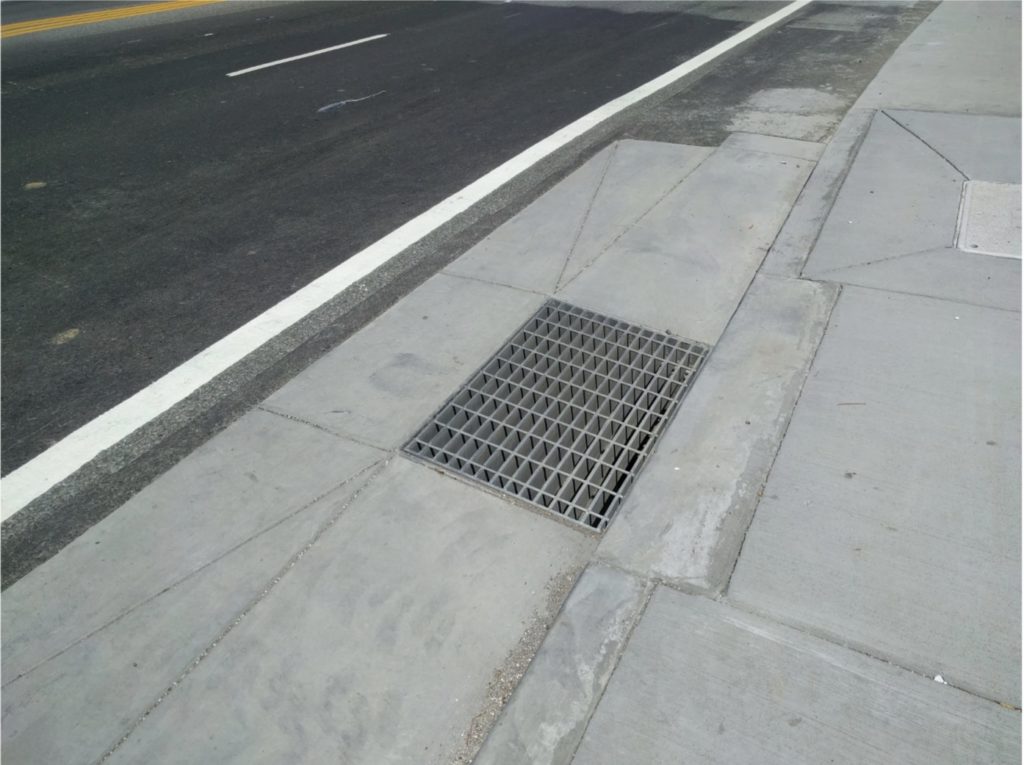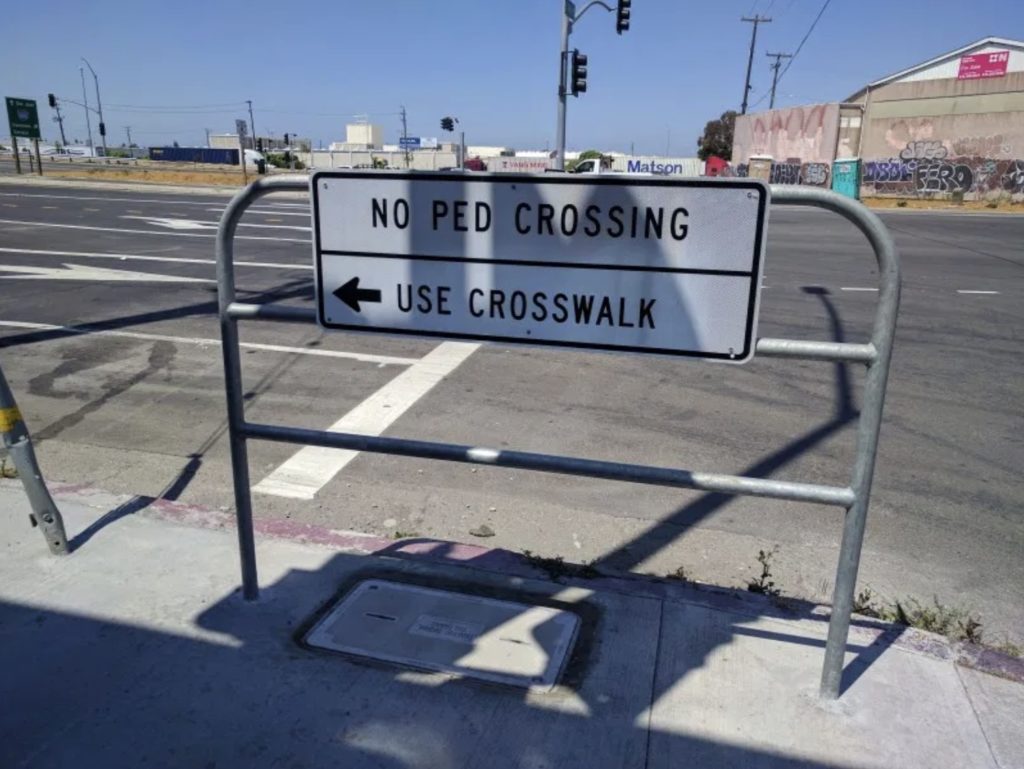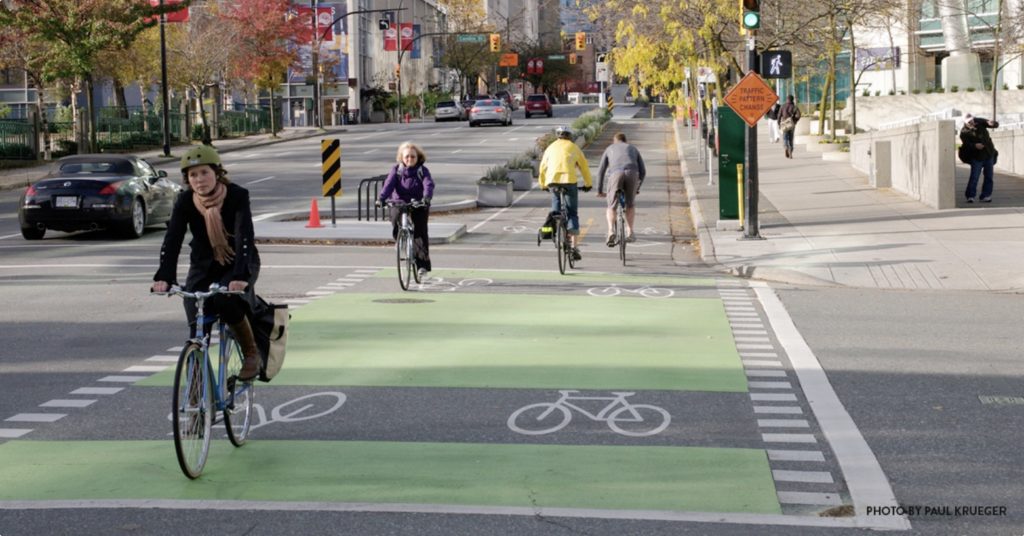Pass the Complete Streets Law.
With a brand-new year stretching out before us, full of promise and hope, it’s a natural time to think not just of what the year will bring to us, but of what we will bring to the year. With that in mind, here is the second of 6! five improvements we can make to California’s bicycle laws.
2. Pass the Complete Streets Law
Let’s say that you “fully support improving facilities to increase walking, biking, and public transit.” And let’s say that you’re the Governor of California. What do you do to back up your words with action?
Well, what if there was a law that required Caltrans, the state transportation agency, to include safe infrastructure for pedestrians, cyclists, and public transit when planning improvements to state routes that also serve as local streets in the cities they pass through? Seems like a fairly innocuous way to walk the walk. So of course if the legislature sent a law like this to your desk, you might jump at the chance to sign it and demonstrate your active and public transportation bona fides.
Unless you’re actually California Governor Gavin Newsom, who vetoed this legislation when it was sent to his desk.

“I am committed to holding the department accountable to deliver more alternatives to driving while continuing to maintain our state’s highways and bridges,” Governor Newsom wrote, while vetoing legislation that would do just that.
Instead, Newsom said that he would rely on new leadership at Caltrans and his executive order on transportation funding and climate goals to accomplish his stated goals.
Ok, here’s the thing. The Complete Streets for Active Living Bill was passed because Caltrans has proven itself to be a recalcitrant automobile infrastructure-oriented agency that is stubbornly resistant to active transportation infrastructure. Well, what about that new Caltrans leadership that Governor Newsom is relying on? Caltrans opposition to the Complete Streets bill—and in particular, Caltrans’ argument that Complete Streets is “too expensive”—was the driving force behind Governor Newsom’s veto. What happened to the new Caltrans leadership?
The Complete Streets for Active Living Bill was not the first attempt at complete streets legislation in California. In 2008, then-Governor Arnold Schwarzenegger signed the Complete Streets Act into law. This law required all cities and counties to consider all users of city and county-owned roads when they update their transportation plans. Caltrans then updated their own policies to apply “Complete Streets” consideration to all state-owned roads.
Unfortunately, while Complete Streets is official Caltrans policy, Caltrans has routinely failed to implement complete streets in its improvement projects, often reasoning that infrastructure for pedestrians, cyclists, and transit would slow automobile traffic.

Caltrans Bicycle Lane, Oakland, California

Caltrans Pedestrian Infrastructure, Oakland, California
Well, duh. Good infrastructure should slow automobile traffic.
With higher traffic speeds, the risks to vulnerable roadway users increases, and we see that reflected in the rising rates of pedestrian and cyclist injuries and fatalities. On the other hand, safe infrastructure for pedestrians and cyclists is safer for drivers too. Everybody wins on complete streets.

Complete Street
But despite its official Complete Streets policy, Caltrans has stubbornly adhered to its actual practice of facilitating higher automobile traffic speeds by not building safe infrastructure for pedestrians, cyclists, and public transit on state-owned roads. The Complete Streets for Active Living Bill was the California Legislature’s response to Caltrans’ sacrifice of complete streets on the altar of automobile supremacy. The new legislation required Caltrans to build pedestrian and bicycle infrastructure in every improvement project on state-owned roads in cities, unless Caltrans held a public hearing on every project which would not include pedestrian and bicycle infrastructure improvements.
The ball was now in Caltrans’ court, and Caltrans changed its excuses, arguing that requiring complete streets is “too expensive.”
And Governor Newsom bought it.
Look, Governor Newsom flubbed this one big-time. But as I’ve noted before, it’s still early in his first term, and I don’t think he’s beyond redemption. We can and should give him another chance to get bicycle safety right, by passing a new Complete Streets Bill and sending it to the Governor for his signature, this time putting him on notice that we won’t accept tired and disingenuous excuses from Caltrans as a substitute for real action.
For more information about Complete Streets, see:
- Complete Streets Fact Sheet
***
Complete streets are designed to ensure that all roadway users have safe infrastructure access to the roadway. A complete street makes it easy for people to safely cross the street, walk to shops, or ride a bike to their destination. Unfortunately, very few streets qualify as a “complete street,” and we can see the results of that failure to build safe infrastructure in rising pedestrian and cyclist injuries and fatalities.
If you have been injured in a crash, contact bicyclelaw.com or another personal injury attorney who understands bicycling. While many attorneys are competent to handle general injury cases, make sure your attorney has experience and is familiar with:
- Bicycle traffic laws
- Negotiating bicycle accident cases with insurance companies
- Trying bicycle accident cases in court
- The prevailing prejudice against cyclists by motorists and juries
- The names and functions of all bicycle components
- The speed bikes travel as well as braking and cornering
- Bicycle handling skills, techniques, and customs
- How to get the full replacement value property damage estimates for your bicycle
- Establishing the value of lost riding time
- Leading bicycle accident reconstruction experts
- Licensed forensic bicycle engineers
- Establishing the value of permanent diminished riding ability
For more information
For information about protecting yourself with insurance, see Insurance Advice.
For more in-depth information about accidents and insurance, see Bicycling & the Law.
For information on avoiding accidents before they occur, see How to Avoid Car-On-Bike Accidents.
Related Article: Why We Say “Bicycle Accidents” Are Not Accidents
If you have been injured in a bicycle accident, whether in a solo accident that may be the result of another party’s negligence, or in a collision with another person, contact bicyclelaw.com for a free consultation.




